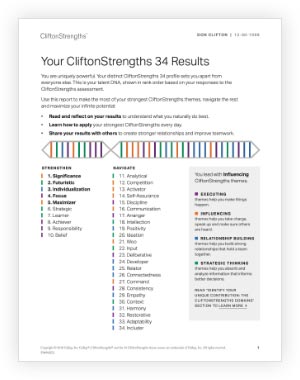Story Highlights
- The CliftonStrengths assessment has been taken 25 million times
- The data show that demographics indicate little about a person's strengths
- Strengths affect team performance and improve organizational outcomes
Almost 30 years ago, Dr. Don Clifton issued the world a challenge: "Focus on strengths and manage the weaknesses." It was a counterintuitive charge. At the time, leaders of all types of organizations believed people could only find success by fixing their weaknesses.
Many still hold that belief. But Dr. Clifton knew that managers and leaders could change organizations -- indeed, workplace cultures -- by focusing on people's strengths.
Dr. Clifton hoped that someday a million people would come to harness the power of their innate patterns of thought, feeling and behavior. His dream has been realized many times over. In fact, today the assessment that came to be named in his honor, the CliftonStrengths assessment, has been completed 25 million times.
That's a lot of lives that have been changed by strengths, and it's also an enormous opportunity for discovery. Recently Gallup analyzed the aggregated data of those 25 million completed assessments and found that:
- Race, gender and nationality indicate almost nothing about a person's strengths. The tremendous variability in strengths profiles all over the world affirms Dr. Clifton's insights about the unique value of every individual.
- Strengths affect team performance, especially when they're coached.
- A strengths-based philosophy improves employee engagement for stronger performance outcomes.
Those discoveries are separate and discrete. But taken as a whole, they indicate ways leaders can "focus on strengths and manage the weaknesses" of employees in a rapidly transforming work environment. So let's examine these insights one by one.
Race, gender, and nationality indicate almost nothing about a person's strengths.
Demographics are not destiny -- everyone is almost equally likely to have any of the 34 CliftonStrengths themes. The largest difference between demographic groups is between genders, and then only on two strengths, Analytical and Empathy. Yet Gallup found that, on average, gender accounts for only 4% of the variation in scores for these themes. Differences by race or ethnicity are much smaller, with race accounting for less than 1.8% of the variation in theme scores for all 34 themes.
Demographics are not destiny -- everyone is almost equally likely to have any of the 34 CliftonStrengths themes.
Patterns by age are more relevant. Strengths form over time in a developmental process, so we found a more differentiated theme profile between the oldest and youngest respondents. The theme of Futuristic shows the most variation by age -- young respondents are more likely to have it than are older respondents.
These demographic patterns indicate the importance of focusing on the individual and drawing no assumptions from identifiable demographic characteristics. There is a rich variety in strengths profiles all over the world and within most organizations.
Strengths affect team performance, especially when they're coached.
To examine the effect of strengths on team performance, Gallup workplace scientists looked at the composition of strengths on 11,441 teams, their engagement scores, and their performance outcomes. The data show that the strengths present on a team do impact performance -- but the effect is much stronger when team members know their CliftonStrengths. Teams where 90% of employees or more know their strengths have substantially higher engagement.
Simply knowing the vocabulary of CliftonStrengths gives teams a shared language to describe the patterns of thought, feeling and behavior that shape their world. That's helpful. But managers who coach with CliftonStrengths in mind -- usually with frequent check-ins, meaningful conversations, and a growth mindset -- see employees as people first and the specific value they contribute to the organization. That coaching perspective has a downstream effect far greater than a shared language alone.
Coaching creates:
- Employees who can name and understand the individual talents of everyone on the team.
- Team members who can see the link between strengths, behavior and success.
- Partnerships that encourage employees' strengths development.
- The ability to plan, strategize, analyze and direct actions on an individual and team level.
Those results are aided by support systems and structures that maximize each person's strengths. In Gallup's experience, building those systems is a process that takes time. But it's time well-spent -- it enables managers to study success and empower more of it.
A strengths-based philosophy improves employee engagement for stronger performance outcomes.
For decades Gallup has asserted that world-class managers do one thing differently than other managers: They focus on productive and developmental conversations with employees. Those conversations identify workers' past successes and coach them toward repeat performance -- but they also increase employee engagement.
Employee engagement has important business implications. Gallup analysis shows that those scoring in the top quartile on employee engagement significantly outperformed those in the bottom quartile on these crucial performance outcomes:
- 81% lower absenteeism
- 64% fewer safety incidents
- 41% fewer defects (quality)
- 14% higher productivity
- 10% higher customer ratings
- 18% higher sales
- 23% higher profitability
These results are tied to engagement, which is not associated with the kind of one-off development efforts that leave employees with little more than a workbook. Rather, they're associated with conversations individualized to the worker's development. Those kinds of conversations enable managers to coach workers toward what they do best, building relationships that engage and, subsequently, improve performance.
It's time for some new questions.
When he was still a graduate student, Dr. Clifton asked himself a question: "What would happen if we studied what was right with people versus what's wrong with people?" That question transformed his life -- and millions of other people's -- and directed organizational psychology toward a new, more constructive view of people.
The transformation isn't complete. We all -- and leaders in particular -- still tend to think of weaknesses as areas of opportunity, rather than what they are: the probability of mediocrity. We still don't focus enough on our strengths. We pay even less attention to the strengths of others.
We all -- and leaders in particular -- still tend to think of weaknesses as areas of opportunity, rather than what they are: the probability of mediocrity.
Except for the 25 million people who took Dr. Clifton's challenge to heart. They and some very outcome-obsessed leaders have an intense fixation on their talents. Those strengths -- and managers' abilities to coach and develop them in their teams (and themselves) -- are an incredible resource. If enough people join them, businesses and societies will change for the better.
So now that Dr. Clifton's challenge has been met 25 times over, perhaps it's time to ask some new questions: What would happen if a billion people of all races, ethnicities and genders knew what was right with them? What would happen to companies if a billion people were coached to use their strengths to their full potential, instead of trying to "fix" their weaknesses? What would happen to engagement if a billion people worked in roles or for organizations where their strengths were embraced?
Today's data have some powerful implications. The day Gallup can study the aggregate data of a billion completed CliftonStrengths assessments, the world will be a different, better place.
Make strengths development part of your plan for the future:
- Start by discovering yours.
- Empower leaders and managers to coach teams to greatness.
- Attend the Gallup at Work Summit for the best thinking on CliftonStrengths and the art and science of life at work.






